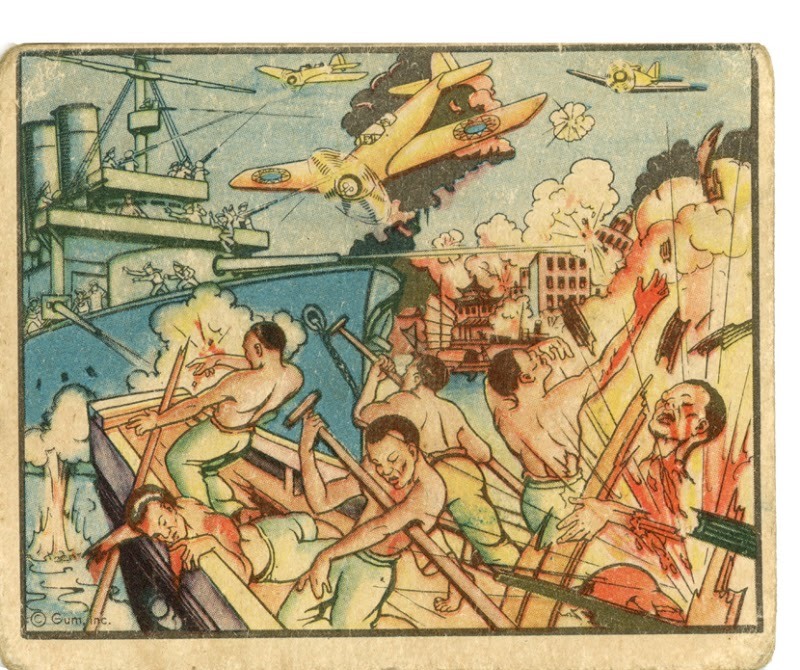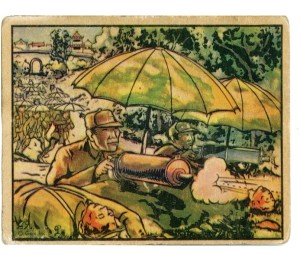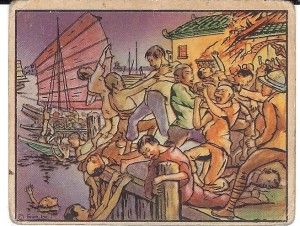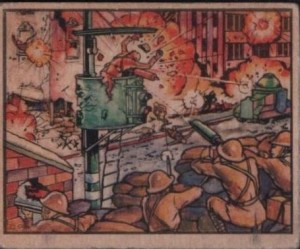‘Horrors of War’
- By Peter Harmsen
- 27 November, 2013
- No Comments
 “Horrors of War” was the name of a series of bubble-gum cards issued in the United States in the late 1930s. The pictures, dealing with bloodshed in the two faraway battlefields of Spain and China, often focused on the exotic aspects of their subject matter, for example Chinese soldiers equipped with umbrellas. But more than anything the gruesome material, represented in an unusually graphic manner, brought the reality of the twin tragedies closer to the American public than perhaps any other medium at the time.
“Horrors of War” was the name of a series of bubble-gum cards issued in the United States in the late 1930s. The pictures, dealing with bloodshed in the two faraway battlefields of Spain and China, often focused on the exotic aspects of their subject matter, for example Chinese soldiers equipped with umbrellas. But more than anything the gruesome material, represented in an unusually graphic manner, brought the reality of the twin tragedies closer to the American public than perhaps any other medium at the time.
 The reverse of the cards had texts to match the illustrations, as in this description of Chinese soldiers trying the escape the city of Nanjing across the Yangtze River on the eve of Japanese occupation: “In the mad rush some stumbled and fell under the pounding feet of the milling crowd. Others were shot down by cursing comrades… Many men were drowned in the feverish manning of boats. Others attempting to swim across… were swept away on the tide.”
The reverse of the cards had texts to match the illustrations, as in this description of Chinese soldiers trying the escape the city of Nanjing across the Yangtze River on the eve of Japanese occupation: “In the mad rush some stumbled and fell under the pounding feet of the milling crowd. Others were shot down by cursing comrades… Many men were drowned in the feverish manning of boats. Others attempting to swim across… were swept away on the tide.”

In this stark description of war, there was not even a hint of glorification. After all, it was only two decades after the United States itself had entered into the First World War, and memories of the slaughter in the trenches were far too vivid for militarist attitudes to have any appeal in the American public. In fact, pacifism was widespread, mixed with great reluctance to get involved once more abroad. The bubble gum cards spoke for many when they invariably stated that “to know the HORRORS OF WAR is to want PEACE.”
 Not everyone liked the cards, least of all the Japanese, whose war crimes were communicated to members of the American public, especially the young, who might otherwise never have been informed about the fateful events taking place in China at the time. The titles of some of the cards, such as “Japanese Bomb Orphanage,” spoke for themselves. In the end, Bowman and Gum Inc, the producer of the cards, was forced to stop otherwise extremely successful gum sales in Japan.
Not everyone liked the cards, least of all the Japanese, whose war crimes were communicated to members of the American public, especially the young, who might otherwise never have been informed about the fateful events taking place in China at the time. The titles of some of the cards, such as “Japanese Bomb Orphanage,” spoke for themselves. In the end, Bowman and Gum Inc, the producer of the cards, was forced to stop otherwise extremely successful gum sales in Japan.



 Copyright © 2025
Copyright © 2025
Leave a Reply